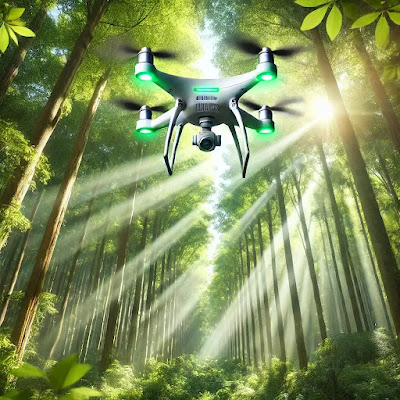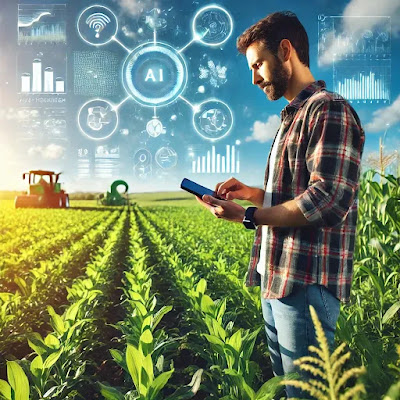 |
| Ai agriculture image.jpg |
Introduction:
Long ago, when the world was filled only with the untouched beauty of nature, everything evolved at its own pace, guided by an ancient wisdom. The towering Peepal and Neem trees stood as guardians of the land, witnessing the rhythm of changing seasons—blooming, shedding, and resting—without ever uprooting themselves. These trees symbolized stability and patience, thriving in harmony with the environment without interference.
Then, one day, a new force emerged—Artificial Intelligence (AI). Like a small seed planted in fertile soil, AI began to grow quietly, taking root across the world. Its spread, though slow at first, soon became unstoppable. Just as roots silently expand beneath the surface, AI began embedding itself into every corner of human life—reshaping industries, changing communication, and influencing decision-making. From its early stages, it extended like the branches of a tree, covering vast landscapes of human activity.
The arrival of AI introduced a profound shift, marking the beginning of a new era where the natural and artificial intersect. While Peepal and Neem symbolize continuity with nature, AI represents rapid transformation and progress. Now, the world must find a way to coexist with this new force—just as the ancient trees adapted to time and change without losing their essence. The question remains: will humanity integrate AI in harmony, or will it struggle to keep pace with the ever-growing roots of this new technology?
1. Nature’s Timeless Wisdom:
The story begins deep within a forest where trees, mountains, and rivers lived in peaceful harmony. Among them was an ancient Peepal tree that held wisdom through the ages. It had seen how species evolved, how humans discovered fire, and how the relationship between humans and nature changed over time. Yet, the Peepal tree never worried, for its roots were grounded in knowledge and patience.
Then one day, a new form of evolution emerged – AI technology. Unlike anything nature had seen before, this new creation had the potential to transform the way the world functioned.
2. AI: The Seed of a New Evolution:
Like a small seed that relies on nature to grow into a tree, AI began its journey fueled by human intelligence and machine learning. AI, once just a concept, started evolving through advancements in deep learning and data analysis. It was used in everything from agriculture to environmental research, helping humans understand the world around them in new ways.
 |
| monitor crops and optimize agricultural.jpg |
3. Nature and AI: A Journey of Collaboration:
Just as the Neem tree naturally repels harmful insects, AI applications in nature conservation helped to identify threats to biodiversity and protect ecosystems. AI was not here to dominate nature but to collaborate with it.
For instance, AI-powered drones began to monitor forests, tracking illegal logging activities and helping conservationists take swift action. AI systems analyzed the health of coral reefs, predicting which areas needed urgent attention. This partnership between AI and nature brought hope that technology could be used responsibly to nurture the Earth.
4. The Importance of Music:
When we think about the beauty of nature and the possibilities of AI, music is an element that strengthens the bond between the two. Whether you are working in the fields or spending time in the embrace of nature, the right music can make your experience even more special.
5. Challenges Faced by Nature and AI:
However, like every evolving system, the collaboration between nature and AI faced challenges. The trees asked AI, “Can you adapt to the ever-changing rhythms of the natural world? Will your growth come at the cost of our balance?”
AI responded, “I am evolving, just as you have. But I rely on humans to guide my use responsibly. Without their wisdom, I could harm the very environment I seek to protect.”
The Peepal tree, with its ancient wisdom, replied, “Everything in nature has a cycle. To truly grow, you must ensure that you are used in balance, respecting the needs of the Earth.”
6. The Symbiosis of AI and Nature:
As AI and nature’s journey progressed, a new era began. Humans started using AI for environmental sustainability, applying its power in ways that strengthened nature’s resilience. AI sensors in agriculture ensured that water usage was optimized, minimizing waste. AI-driven robots were employed to plant trees in areas affected by deforestation.
AI also aided scientists in biomedical research, helping to discover new medicines derived from plants. This synergy between AI and nature created a world where both could thrive
 |
| A harmonious future where AI. jpg. |
Just as the Peepal and Neem trees provide life to all around them, the union of Artificial Intelligence and nature gave birth to a renewed hope for the planet. However, this symbiosis could only last if humanity used AI responsibly. Just as nature always maintains balance, so too must AI be harnessed wisely.
My Perspective on AI:
I believe that artificial intelligence has the potential to revolutionize our relationship with nature. By integrating AI into environmental conservation, we can enhance our ability to monitor ecosystems, optimize resource management, and promote sustainable practices. AI can serve as a powerful ally in preserving our planet for future generations.
Conclusion:
AI and nature are not adversaries; they are partners in evolution. Like the trees that bring life to their surroundings, AI, when developed with care, can usher in a brighter future for the Earth. It’s up to us to use this technology to not only enhance our world but also to protect it.
Disclaimer:
Image credit: Generated by DALL-E, an AI image creation tool. This image is for illustrative purposes only and may not represent a real-world scenario.
Comments
Post a Comment